The Rise and Fall of Communism in Poland: A Historical Perspective
VerifiedAdded on 2022/08/21
|14
|3183
|9
Essay
AI Summary
This essay provides a comprehensive historical analysis of the factors that led to the collapse of the communist regime in Poland. It examines the socio-political context of Poland during the late 1970s, highlighting the rise of the Solidarity trade union movement and the significant influence of Pope John Paul II and the Catholic Church. The essay details the economic failures of the communist government, including price hikes, lack of civil rights, and the practice of patronage, which fueled widespread discontent among the Polish people. It explores the key events, such as workers' protests, the burning of the Communist Party headquarters, and the imposition of curfews, that ultimately led to the downfall of the regime. The essay also discusses the role of international factors and the impact of the Pope's leadership in inspiring the Polish people to resist oppression and demand freedom. Overall, the essay presents a detailed account of the historical forces that brought an end to communism in Poland.
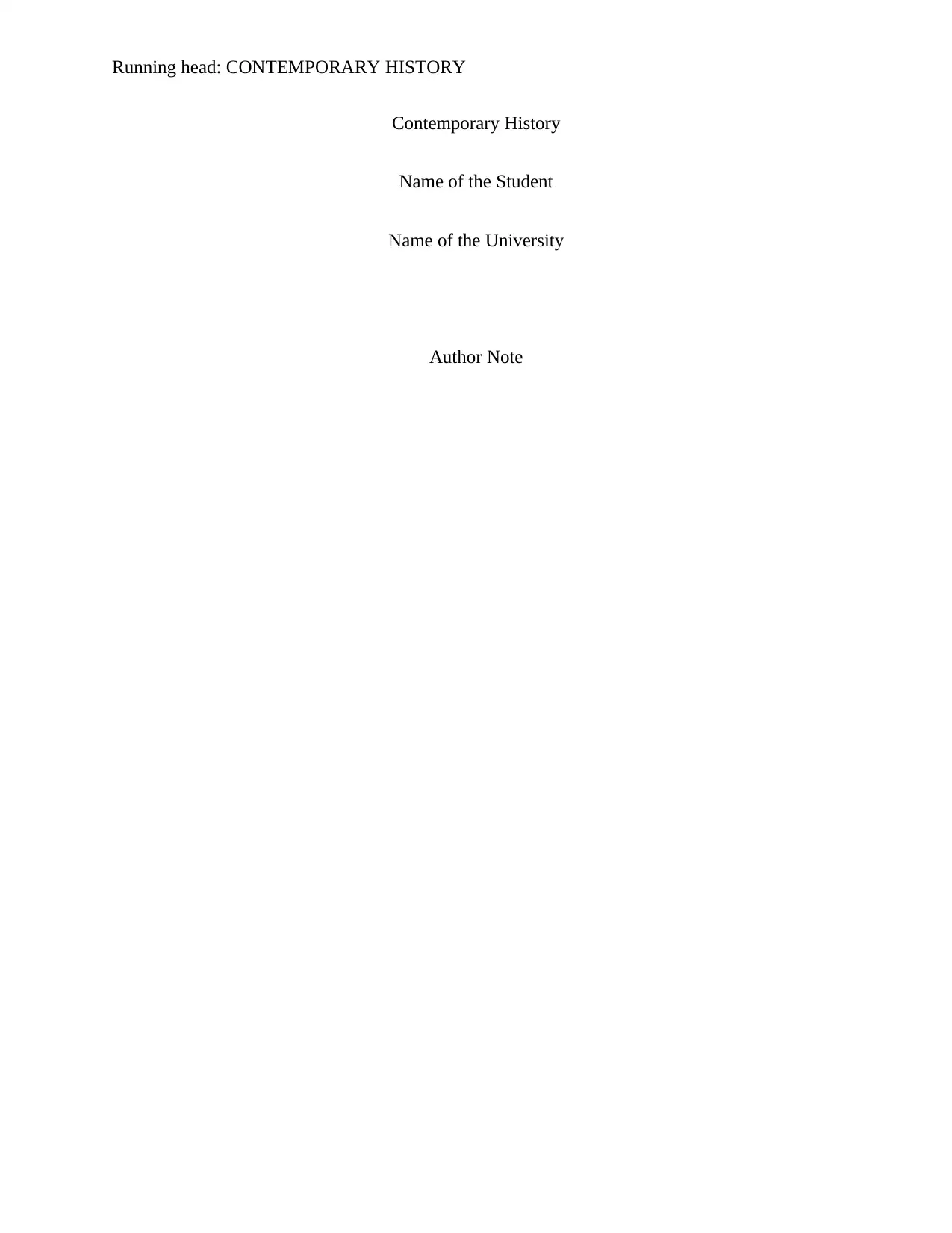
Running head: CONTEMPORARY HISTORY
Contemporary History
Name of the Student
Name of the University
Author Note
Contemporary History
Name of the Student
Name of the University
Author Note
Paraphrase This Document
Need a fresh take? Get an instant paraphrase of this document with our AI Paraphraser
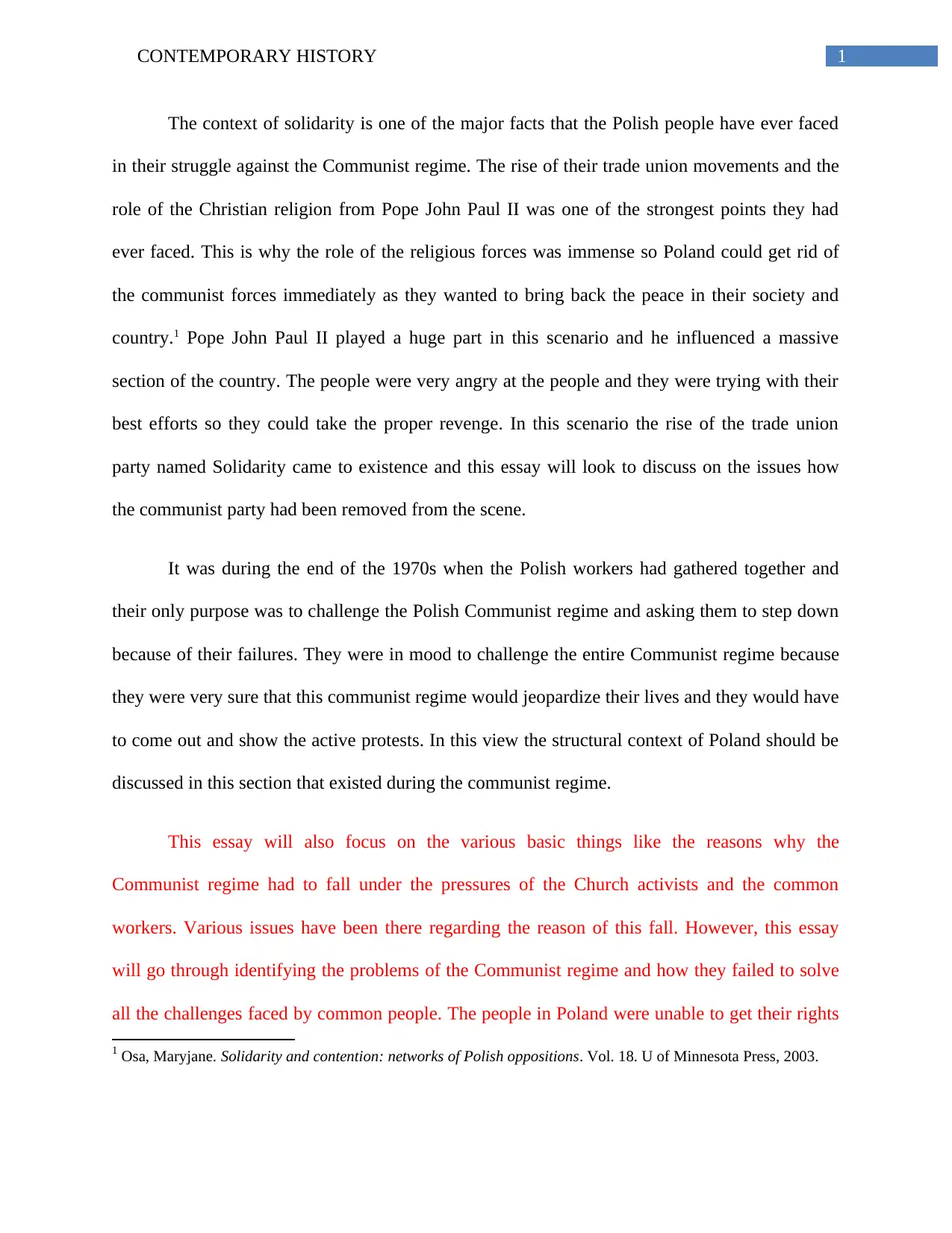
1CONTEMPORARY HISTORY
The context of solidarity is one of the major facts that the Polish people have ever faced
in their struggle against the Communist regime. The rise of their trade union movements and the
role of the Christian religion from Pope John Paul II was one of the strongest points they had
ever faced. This is why the role of the religious forces was immense so Poland could get rid of
the communist forces immediately as they wanted to bring back the peace in their society and
country.1 Pope John Paul II played a huge part in this scenario and he influenced a massive
section of the country. The people were very angry at the people and they were trying with their
best efforts so they could take the proper revenge. In this scenario the rise of the trade union
party named Solidarity came to existence and this essay will look to discuss on the issues how
the communist party had been removed from the scene.
It was during the end of the 1970s when the Polish workers had gathered together and
their only purpose was to challenge the Polish Communist regime and asking them to step down
because of their failures. They were in mood to challenge the entire Communist regime because
they were very sure that this communist regime would jeopardize their lives and they would have
to come out and show the active protests. In this view the structural context of Poland should be
discussed in this section that existed during the communist regime.
This essay will also focus on the various basic things like the reasons why the
Communist regime had to fall under the pressures of the Church activists and the common
workers. Various issues have been there regarding the reason of this fall. However, this essay
will go through identifying the problems of the Communist regime and how they failed to solve
all the challenges faced by common people. The people in Poland were unable to get their rights
1 Osa, Maryjane. Solidarity and contention: networks of Polish oppositions. Vol. 18. U of Minnesota Press, 2003.
The context of solidarity is one of the major facts that the Polish people have ever faced
in their struggle against the Communist regime. The rise of their trade union movements and the
role of the Christian religion from Pope John Paul II was one of the strongest points they had
ever faced. This is why the role of the religious forces was immense so Poland could get rid of
the communist forces immediately as they wanted to bring back the peace in their society and
country.1 Pope John Paul II played a huge part in this scenario and he influenced a massive
section of the country. The people were very angry at the people and they were trying with their
best efforts so they could take the proper revenge. In this scenario the rise of the trade union
party named Solidarity came to existence and this essay will look to discuss on the issues how
the communist party had been removed from the scene.
It was during the end of the 1970s when the Polish workers had gathered together and
their only purpose was to challenge the Polish Communist regime and asking them to step down
because of their failures. They were in mood to challenge the entire Communist regime because
they were very sure that this communist regime would jeopardize their lives and they would have
to come out and show the active protests. In this view the structural context of Poland should be
discussed in this section that existed during the communist regime.
This essay will also focus on the various basic things like the reasons why the
Communist regime had to fall under the pressures of the Church activists and the common
workers. Various issues have been there regarding the reason of this fall. However, this essay
will go through identifying the problems of the Communist regime and how they failed to solve
all the challenges faced by common people. The people in Poland were unable to get their rights
1 Osa, Maryjane. Solidarity and contention: networks of Polish oppositions. Vol. 18. U of Minnesota Press, 2003.
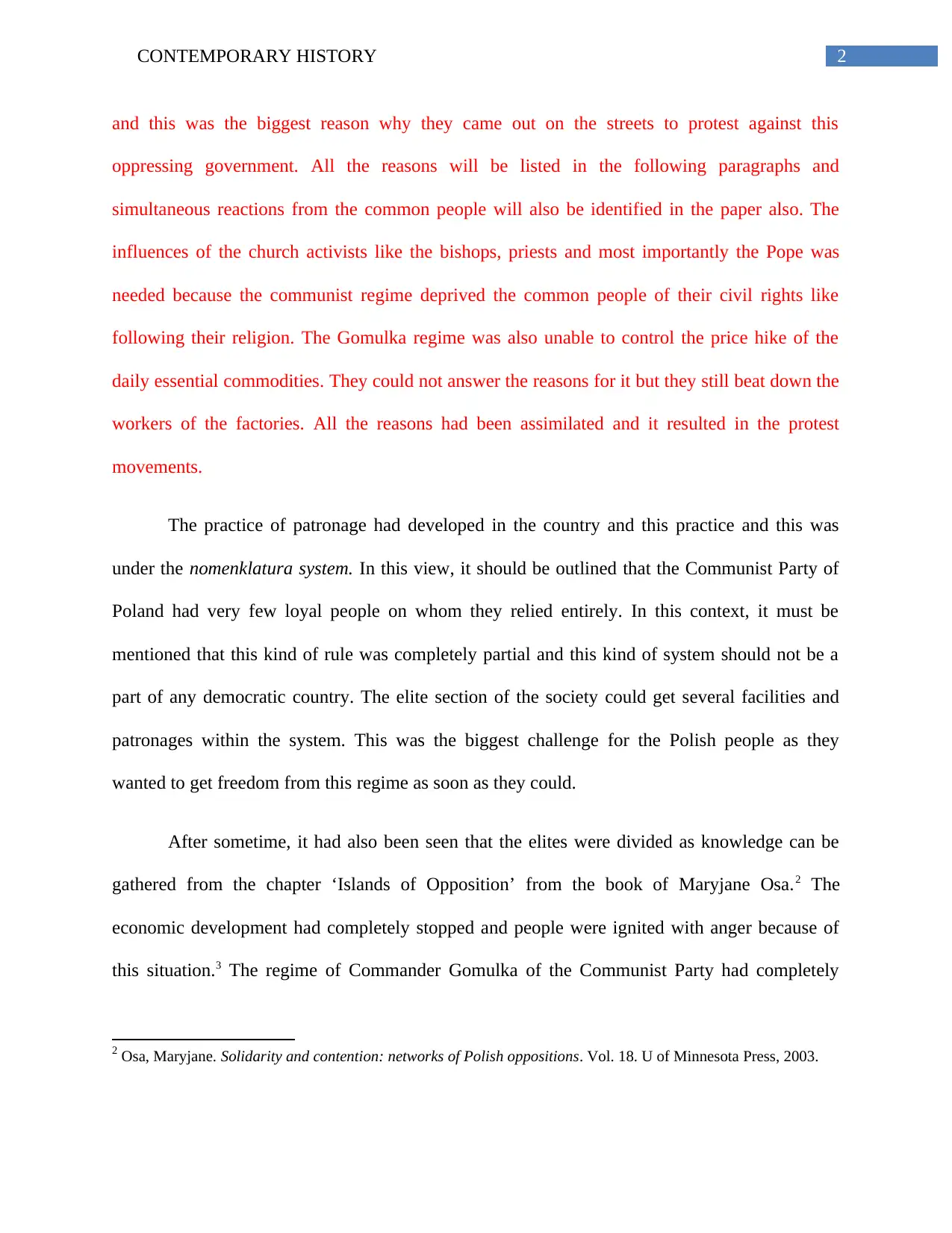
2CONTEMPORARY HISTORY
and this was the biggest reason why they came out on the streets to protest against this
oppressing government. All the reasons will be listed in the following paragraphs and
simultaneous reactions from the common people will also be identified in the paper also. The
influences of the church activists like the bishops, priests and most importantly the Pope was
needed because the communist regime deprived the common people of their civil rights like
following their religion. The Gomulka regime was also unable to control the price hike of the
daily essential commodities. They could not answer the reasons for it but they still beat down the
workers of the factories. All the reasons had been assimilated and it resulted in the protest
movements.
The practice of patronage had developed in the country and this practice and this was
under the nomenklatura system. In this view, it should be outlined that the Communist Party of
Poland had very few loyal people on whom they relied entirely. In this context, it must be
mentioned that this kind of rule was completely partial and this kind of system should not be a
part of any democratic country. The elite section of the society could get several facilities and
patronages within the system. This was the biggest challenge for the Polish people as they
wanted to get freedom from this regime as soon as they could.
After sometime, it had also been seen that the elites were divided as knowledge can be
gathered from the chapter ‘Islands of Opposition’ from the book of Maryjane Osa.2 The
economic development had completely stopped and people were ignited with anger because of
this situation.3 The regime of Commander Gomulka of the Communist Party had completely
2 Osa, Maryjane. Solidarity and contention: networks of Polish oppositions. Vol. 18. U of Minnesota Press, 2003.
and this was the biggest reason why they came out on the streets to protest against this
oppressing government. All the reasons will be listed in the following paragraphs and
simultaneous reactions from the common people will also be identified in the paper also. The
influences of the church activists like the bishops, priests and most importantly the Pope was
needed because the communist regime deprived the common people of their civil rights like
following their religion. The Gomulka regime was also unable to control the price hike of the
daily essential commodities. They could not answer the reasons for it but they still beat down the
workers of the factories. All the reasons had been assimilated and it resulted in the protest
movements.
The practice of patronage had developed in the country and this practice and this was
under the nomenklatura system. In this view, it should be outlined that the Communist Party of
Poland had very few loyal people on whom they relied entirely. In this context, it must be
mentioned that this kind of rule was completely partial and this kind of system should not be a
part of any democratic country. The elite section of the society could get several facilities and
patronages within the system. This was the biggest challenge for the Polish people as they
wanted to get freedom from this regime as soon as they could.
After sometime, it had also been seen that the elites were divided as knowledge can be
gathered from the chapter ‘Islands of Opposition’ from the book of Maryjane Osa.2 The
economic development had completely stopped and people were ignited with anger because of
this situation.3 The regime of Commander Gomulka of the Communist Party had completely
2 Osa, Maryjane. Solidarity and contention: networks of Polish oppositions. Vol. 18. U of Minnesota Press, 2003.
⊘ This is a preview!⊘
Do you want full access?
Subscribe today to unlock all pages.

Trusted by 1+ million students worldwide
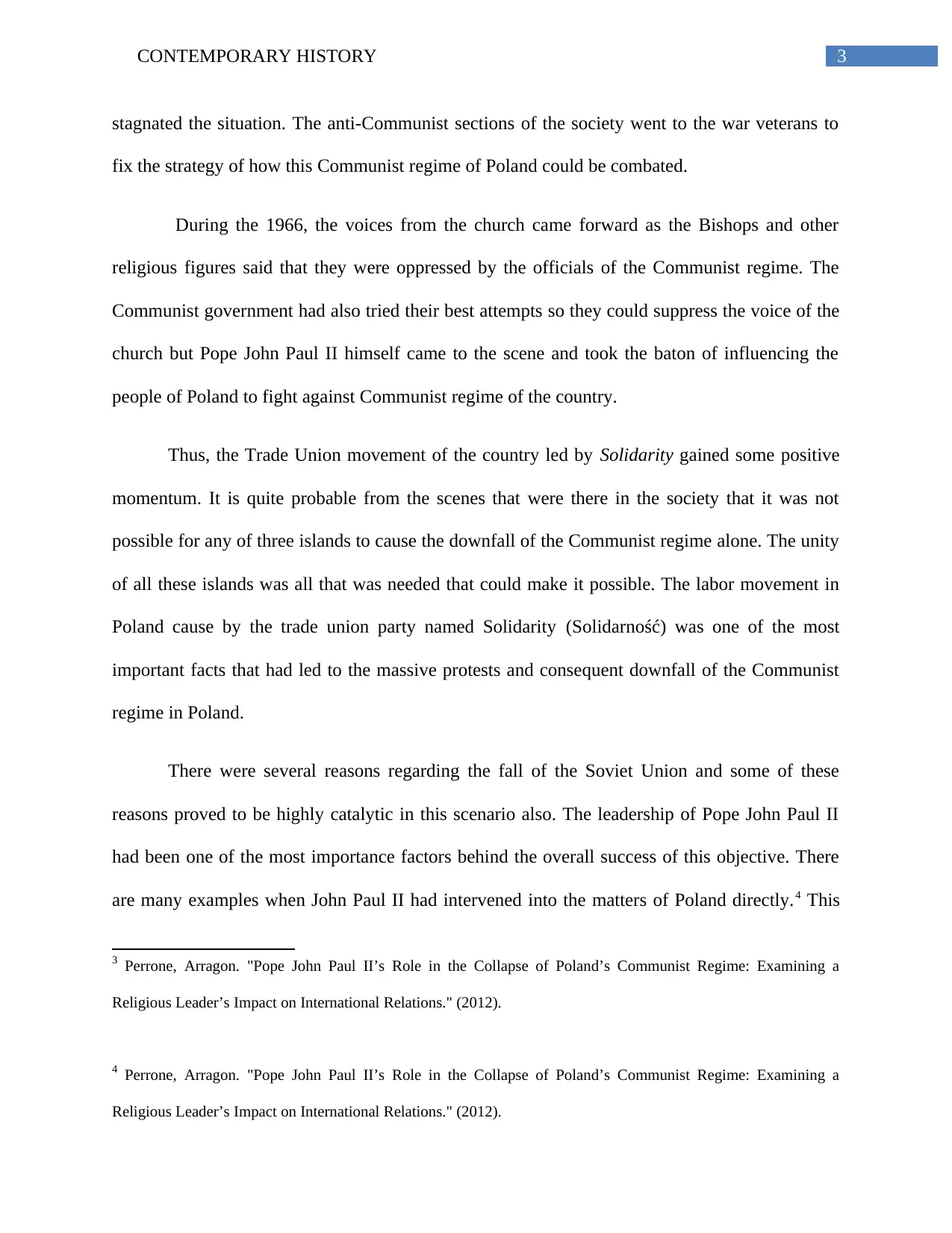
3CONTEMPORARY HISTORY
stagnated the situation. The anti-Communist sections of the society went to the war veterans to
fix the strategy of how this Communist regime of Poland could be combated.
During the 1966, the voices from the church came forward as the Bishops and other
religious figures said that they were oppressed by the officials of the Communist regime. The
Communist government had also tried their best attempts so they could suppress the voice of the
church but Pope John Paul II himself came to the scene and took the baton of influencing the
people of Poland to fight against Communist regime of the country.
Thus, the Trade Union movement of the country led by Solidarity gained some positive
momentum. It is quite probable from the scenes that were there in the society that it was not
possible for any of three islands to cause the downfall of the Communist regime alone. The unity
of all these islands was all that was needed that could make it possible. The labor movement in
Poland cause by the trade union party named Solidarity (Solidarność) was one of the most
important facts that had led to the massive protests and consequent downfall of the Communist
regime in Poland.
There were several reasons regarding the fall of the Soviet Union and some of these
reasons proved to be highly catalytic in this scenario also. The leadership of Pope John Paul II
had been one of the most importance factors behind the overall success of this objective. There
are many examples when John Paul II had intervened into the matters of Poland directly.4 This
3 Perrone, Arragon. "Pope John Paul II’s Role in the Collapse of Poland’s Communist Regime: Examining a
Religious Leader’s Impact on International Relations." (2012).
4 Perrone, Arragon. "Pope John Paul II’s Role in the Collapse of Poland’s Communist Regime: Examining a
Religious Leader’s Impact on International Relations." (2012).
stagnated the situation. The anti-Communist sections of the society went to the war veterans to
fix the strategy of how this Communist regime of Poland could be combated.
During the 1966, the voices from the church came forward as the Bishops and other
religious figures said that they were oppressed by the officials of the Communist regime. The
Communist government had also tried their best attempts so they could suppress the voice of the
church but Pope John Paul II himself came to the scene and took the baton of influencing the
people of Poland to fight against Communist regime of the country.
Thus, the Trade Union movement of the country led by Solidarity gained some positive
momentum. It is quite probable from the scenes that were there in the society that it was not
possible for any of three islands to cause the downfall of the Communist regime alone. The unity
of all these islands was all that was needed that could make it possible. The labor movement in
Poland cause by the trade union party named Solidarity (Solidarność) was one of the most
important facts that had led to the massive protests and consequent downfall of the Communist
regime in Poland.
There were several reasons regarding the fall of the Soviet Union and some of these
reasons proved to be highly catalytic in this scenario also. The leadership of Pope John Paul II
had been one of the most importance factors behind the overall success of this objective. There
are many examples when John Paul II had intervened into the matters of Poland directly.4 This
3 Perrone, Arragon. "Pope John Paul II’s Role in the Collapse of Poland’s Communist Regime: Examining a
Religious Leader’s Impact on International Relations." (2012).
4 Perrone, Arragon. "Pope John Paul II’s Role in the Collapse of Poland’s Communist Regime: Examining a
Religious Leader’s Impact on International Relations." (2012).
Paraphrase This Document
Need a fresh take? Get an instant paraphrase of this document with our AI Paraphraser
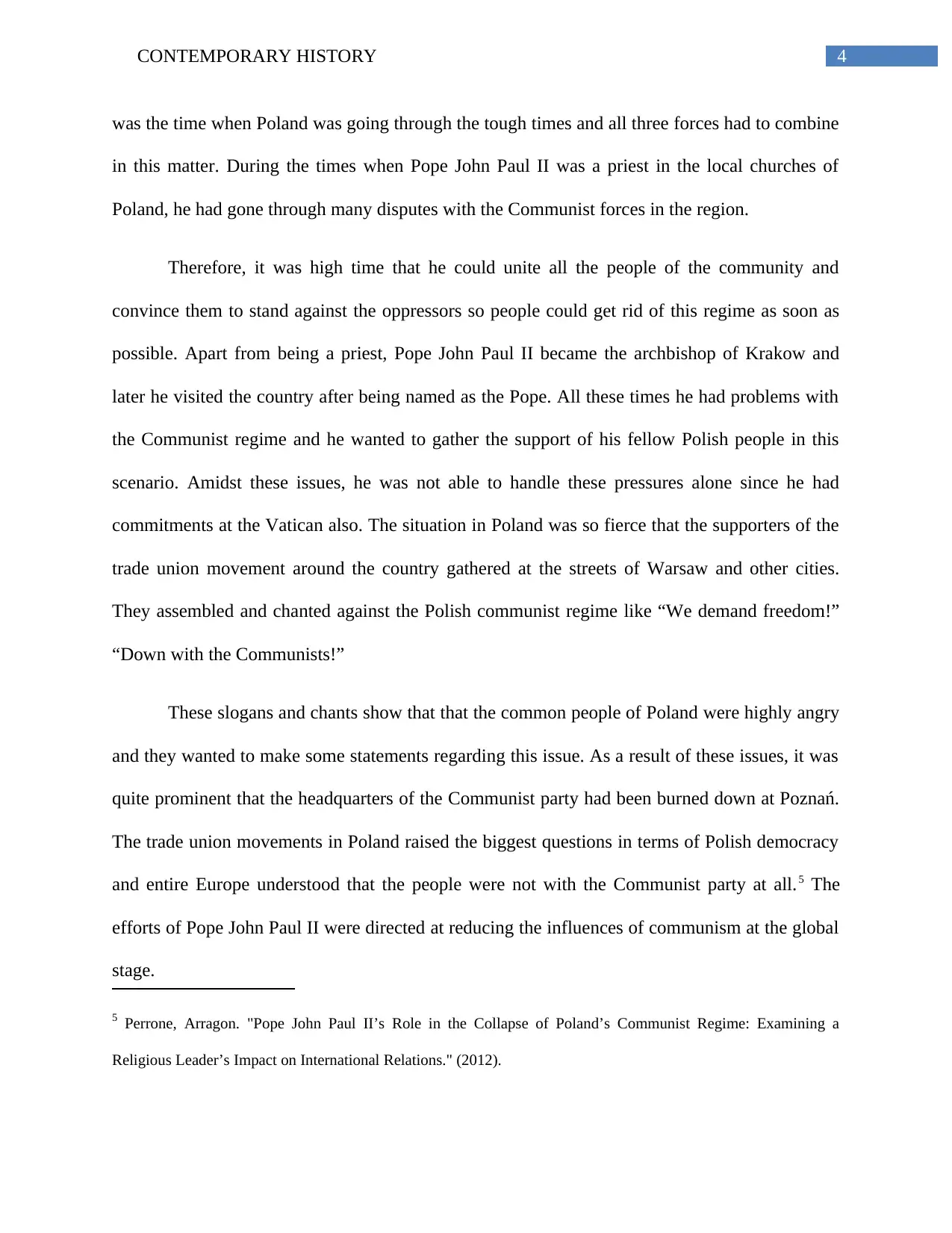
4CONTEMPORARY HISTORY
was the time when Poland was going through the tough times and all three forces had to combine
in this matter. During the times when Pope John Paul II was a priest in the local churches of
Poland, he had gone through many disputes with the Communist forces in the region.
Therefore, it was high time that he could unite all the people of the community and
convince them to stand against the oppressors so people could get rid of this regime as soon as
possible. Apart from being a priest, Pope John Paul II became the archbishop of Krakow and
later he visited the country after being named as the Pope. All these times he had problems with
the Communist regime and he wanted to gather the support of his fellow Polish people in this
scenario. Amidst these issues, he was not able to handle these pressures alone since he had
commitments at the Vatican also. The situation in Poland was so fierce that the supporters of the
trade union movement around the country gathered at the streets of Warsaw and other cities.
They assembled and chanted against the Polish communist regime like “We demand freedom!”
“Down with the Communists!”
These slogans and chants show that that the common people of Poland were highly angry
and they wanted to make some statements regarding this issue. As a result of these issues, it was
quite prominent that the headquarters of the Communist party had been burned down at Poznań.
The trade union movements in Poland raised the biggest questions in terms of Polish democracy
and entire Europe understood that the people were not with the Communist party at all.5 The
efforts of Pope John Paul II were directed at reducing the influences of communism at the global
stage.
5 Perrone, Arragon. "Pope John Paul II’s Role in the Collapse of Poland’s Communist Regime: Examining a
Religious Leader’s Impact on International Relations." (2012).
was the time when Poland was going through the tough times and all three forces had to combine
in this matter. During the times when Pope John Paul II was a priest in the local churches of
Poland, he had gone through many disputes with the Communist forces in the region.
Therefore, it was high time that he could unite all the people of the community and
convince them to stand against the oppressors so people could get rid of this regime as soon as
possible. Apart from being a priest, Pope John Paul II became the archbishop of Krakow and
later he visited the country after being named as the Pope. All these times he had problems with
the Communist regime and he wanted to gather the support of his fellow Polish people in this
scenario. Amidst these issues, he was not able to handle these pressures alone since he had
commitments at the Vatican also. The situation in Poland was so fierce that the supporters of the
trade union movement around the country gathered at the streets of Warsaw and other cities.
They assembled and chanted against the Polish communist regime like “We demand freedom!”
“Down with the Communists!”
These slogans and chants show that that the common people of Poland were highly angry
and they wanted to make some statements regarding this issue. As a result of these issues, it was
quite prominent that the headquarters of the Communist party had been burned down at Poznań.
The trade union movements in Poland raised the biggest questions in terms of Polish democracy
and entire Europe understood that the people were not with the Communist party at all.5 The
efforts of Pope John Paul II were directed at reducing the influences of communism at the global
stage.
5 Perrone, Arragon. "Pope John Paul II’s Role in the Collapse of Poland’s Communist Regime: Examining a
Religious Leader’s Impact on International Relations." (2012).
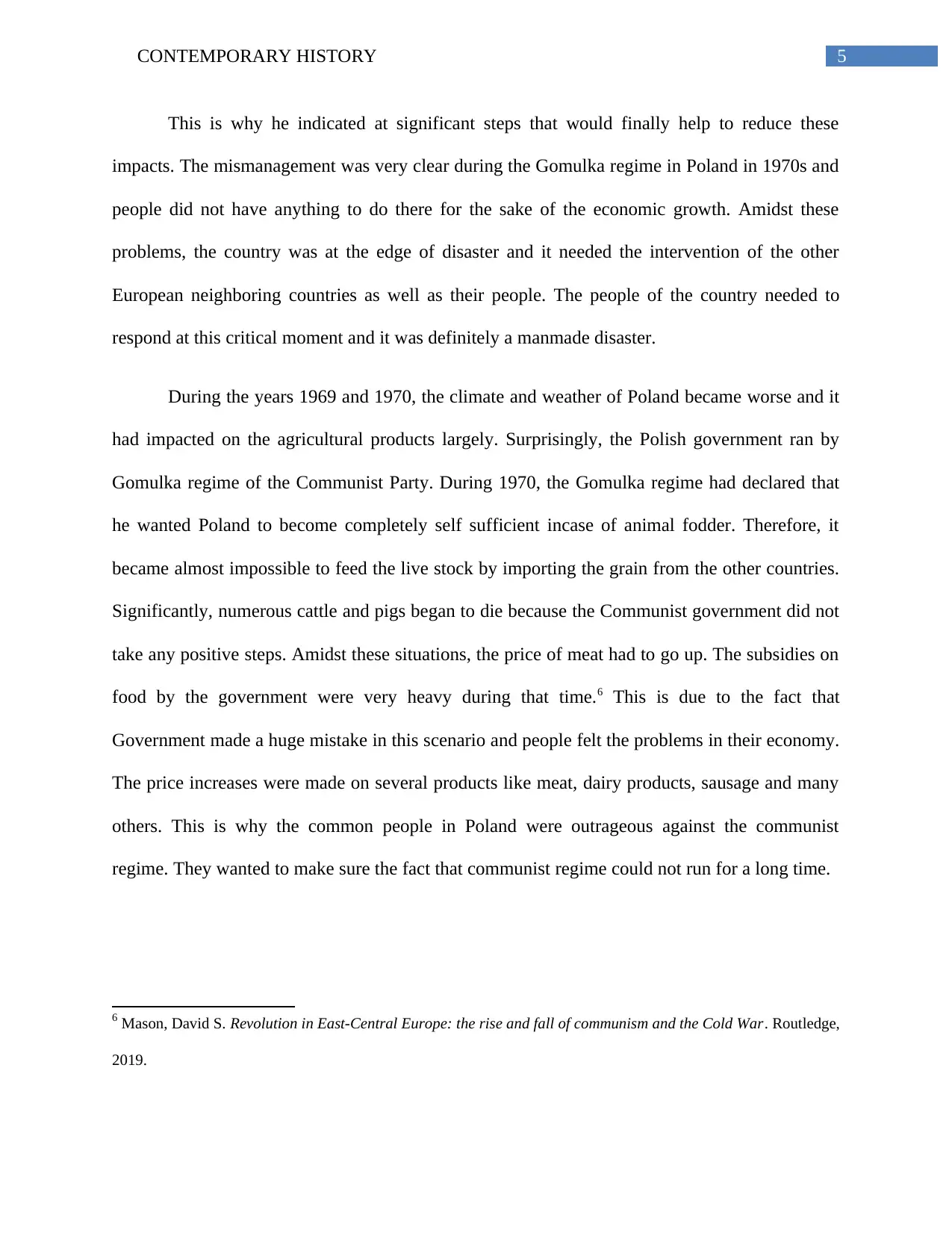
5CONTEMPORARY HISTORY
This is why he indicated at significant steps that would finally help to reduce these
impacts. The mismanagement was very clear during the Gomulka regime in Poland in 1970s and
people did not have anything to do there for the sake of the economic growth. Amidst these
problems, the country was at the edge of disaster and it needed the intervention of the other
European neighboring countries as well as their people. The people of the country needed to
respond at this critical moment and it was definitely a manmade disaster.
During the years 1969 and 1970, the climate and weather of Poland became worse and it
had impacted on the agricultural products largely. Surprisingly, the Polish government ran by
Gomulka regime of the Communist Party. During 1970, the Gomulka regime had declared that
he wanted Poland to become completely self sufficient incase of animal fodder. Therefore, it
became almost impossible to feed the live stock by importing the grain from the other countries.
Significantly, numerous cattle and pigs began to die because the Communist government did not
take any positive steps. Amidst these situations, the price of meat had to go up. The subsidies on
food by the government were very heavy during that time.6 This is due to the fact that
Government made a huge mistake in this scenario and people felt the problems in their economy.
The price increases were made on several products like meat, dairy products, sausage and many
others. This is why the common people in Poland were outrageous against the communist
regime. They wanted to make sure the fact that communist regime could not run for a long time.
6 Mason, David S. Revolution in East-Central Europe: the rise and fall of communism and the Cold War. Routledge,
2019.
This is why he indicated at significant steps that would finally help to reduce these
impacts. The mismanagement was very clear during the Gomulka regime in Poland in 1970s and
people did not have anything to do there for the sake of the economic growth. Amidst these
problems, the country was at the edge of disaster and it needed the intervention of the other
European neighboring countries as well as their people. The people of the country needed to
respond at this critical moment and it was definitely a manmade disaster.
During the years 1969 and 1970, the climate and weather of Poland became worse and it
had impacted on the agricultural products largely. Surprisingly, the Polish government ran by
Gomulka regime of the Communist Party. During 1970, the Gomulka regime had declared that
he wanted Poland to become completely self sufficient incase of animal fodder. Therefore, it
became almost impossible to feed the live stock by importing the grain from the other countries.
Significantly, numerous cattle and pigs began to die because the Communist government did not
take any positive steps. Amidst these situations, the price of meat had to go up. The subsidies on
food by the government were very heavy during that time.6 This is due to the fact that
Government made a huge mistake in this scenario and people felt the problems in their economy.
The price increases were made on several products like meat, dairy products, sausage and many
others. This is why the common people in Poland were outrageous against the communist
regime. They wanted to make sure the fact that communist regime could not run for a long time.
6 Mason, David S. Revolution in East-Central Europe: the rise and fall of communism and the Cold War. Routledge,
2019.
⊘ This is a preview!⊘
Do you want full access?
Subscribe today to unlock all pages.

Trusted by 1+ million students worldwide
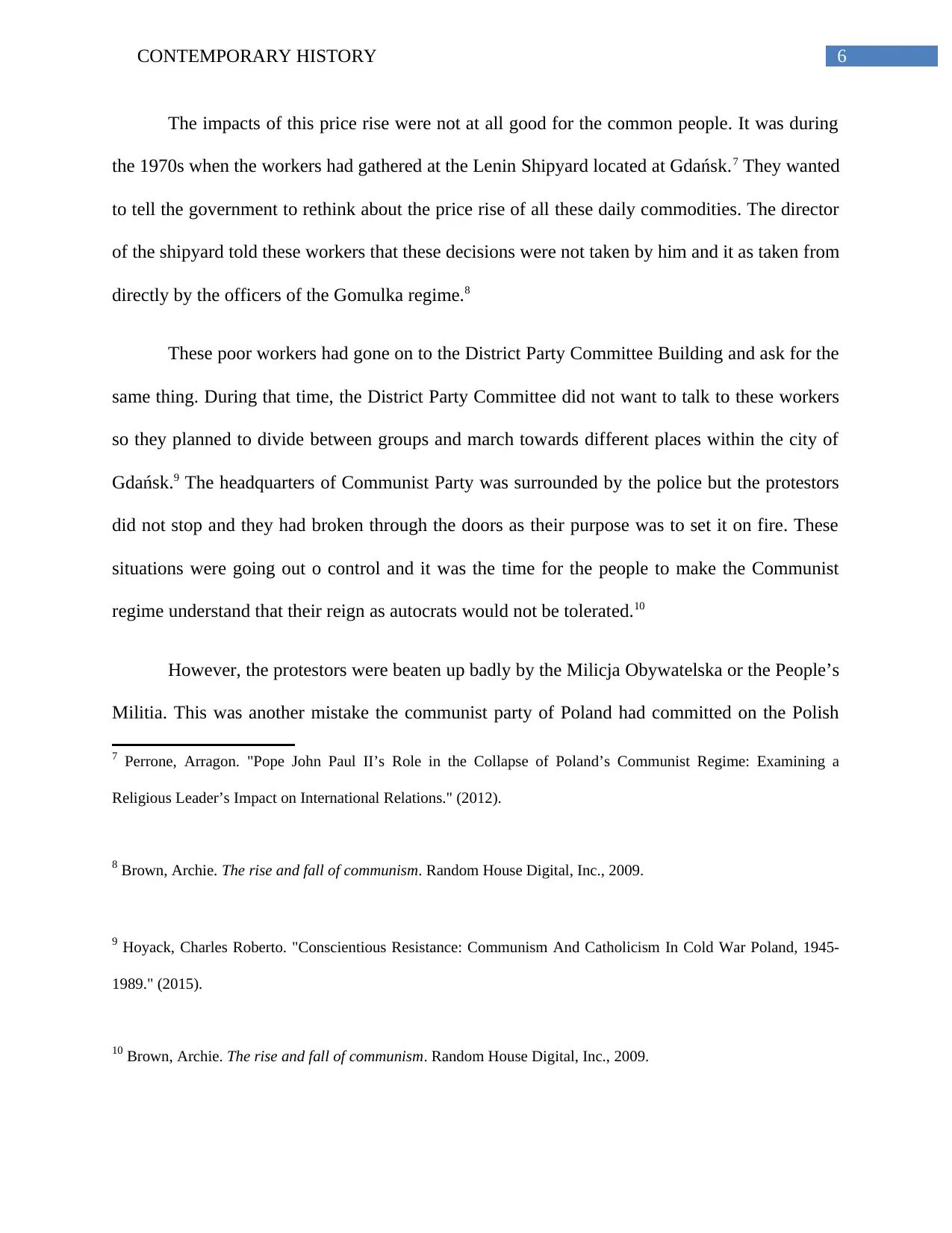
6CONTEMPORARY HISTORY
The impacts of this price rise were not at all good for the common people. It was during
the 1970s when the workers had gathered at the Lenin Shipyard located at Gdańsk.7 They wanted
to tell the government to rethink about the price rise of all these daily commodities. The director
of the shipyard told these workers that these decisions were not taken by him and it as taken from
directly by the officers of the Gomulka regime.8
These poor workers had gone on to the District Party Committee Building and ask for the
same thing. During that time, the District Party Committee did not want to talk to these workers
so they planned to divide between groups and march towards different places within the city of
Gdańsk.9 The headquarters of Communist Party was surrounded by the police but the protestors
did not stop and they had broken through the doors as their purpose was to set it on fire. These
situations were going out o control and it was the time for the people to make the Communist
regime understand that their reign as autocrats would not be tolerated.10
However, the protestors were beaten up badly by the Milicja Obywatelska or the People’s
Militia. This was another mistake the communist party of Poland had committed on the Polish
7 Perrone, Arragon. "Pope John Paul II’s Role in the Collapse of Poland’s Communist Regime: Examining a
Religious Leader’s Impact on International Relations." (2012).
8 Brown, Archie. The rise and fall of communism. Random House Digital, Inc., 2009.
9 Hoyack, Charles Roberto. "Conscientious Resistance: Communism And Catholicism In Cold War Poland, 1945-
1989." (2015).
10 Brown, Archie. The rise and fall of communism. Random House Digital, Inc., 2009.
The impacts of this price rise were not at all good for the common people. It was during
the 1970s when the workers had gathered at the Lenin Shipyard located at Gdańsk.7 They wanted
to tell the government to rethink about the price rise of all these daily commodities. The director
of the shipyard told these workers that these decisions were not taken by him and it as taken from
directly by the officers of the Gomulka regime.8
These poor workers had gone on to the District Party Committee Building and ask for the
same thing. During that time, the District Party Committee did not want to talk to these workers
so they planned to divide between groups and march towards different places within the city of
Gdańsk.9 The headquarters of Communist Party was surrounded by the police but the protestors
did not stop and they had broken through the doors as their purpose was to set it on fire. These
situations were going out o control and it was the time for the people to make the Communist
regime understand that their reign as autocrats would not be tolerated.10
However, the protestors were beaten up badly by the Milicja Obywatelska or the People’s
Militia. This was another mistake the communist party of Poland had committed on the Polish
7 Perrone, Arragon. "Pope John Paul II’s Role in the Collapse of Poland’s Communist Regime: Examining a
Religious Leader’s Impact on International Relations." (2012).
8 Brown, Archie. The rise and fall of communism. Random House Digital, Inc., 2009.
9 Hoyack, Charles Roberto. "Conscientious Resistance: Communism And Catholicism In Cold War Poland, 1945-
1989." (2015).
10 Brown, Archie. The rise and fall of communism. Random House Digital, Inc., 2009.
Paraphrase This Document
Need a fresh take? Get an instant paraphrase of this document with our AI Paraphraser

7CONTEMPORARY HISTORY
people. They did not leave the area and the tensions had risen also. The workers of the region
had torched up the headquarters of the party. Thus, the condition escalated and people began to
feel that this communist regime was of no use.11
The prison had been vandalized completely also. All these situations were against the
Communist party and people did not contain themselves to the city of Gdańsk. The fire of protest
had also spread to the city of Gdynia. Thus the protesting workers came up to rally against these
rallies and they severely wanted to put an end to the Communist regime. The authorities of
Gdynia wanted to have some negotiations with the workers and that made the situation under
control. Therefore, the situation slowly began to go out of hand and the local authority had to
impose the curfew in both the cities Gdynia and Gdańsk.12
The protests were not to stop and people began to come to the places and they issued the
mass gatherings at these places. These mass meetings at the work sites went on and overall
production of the factories were going down completely. This scenario continued and the
workers of Poland slowly began to be united. The grievances for the economic downfall of the
city had remained the same. The local people of these two cities wanted the church authorities to
11 Seton-Watson, Hugh. The East European Revolution. Routledge, 2019.
12 Sil, Rudra. "Liberalization and Labor Incorporation in Postcommunist Europe: A Paired Comparison of Poland
and the Czech Republic." In annual meeting of the International Studies Association, Toronto, Canada, March, pp.
26-29. 2014.
people. They did not leave the area and the tensions had risen also. The workers of the region
had torched up the headquarters of the party. Thus, the condition escalated and people began to
feel that this communist regime was of no use.11
The prison had been vandalized completely also. All these situations were against the
Communist party and people did not contain themselves to the city of Gdańsk. The fire of protest
had also spread to the city of Gdynia. Thus the protesting workers came up to rally against these
rallies and they severely wanted to put an end to the Communist regime. The authorities of
Gdynia wanted to have some negotiations with the workers and that made the situation under
control. Therefore, the situation slowly began to go out of hand and the local authority had to
impose the curfew in both the cities Gdynia and Gdańsk.12
The protests were not to stop and people began to come to the places and they issued the
mass gatherings at these places. These mass meetings at the work sites went on and overall
production of the factories were going down completely. This scenario continued and the
workers of Poland slowly began to be united. The grievances for the economic downfall of the
city had remained the same. The local people of these two cities wanted the church authorities to
11 Seton-Watson, Hugh. The East European Revolution. Routledge, 2019.
12 Sil, Rudra. "Liberalization and Labor Incorporation in Postcommunist Europe: A Paired Comparison of Poland
and the Czech Republic." In annual meeting of the International Studies Association, Toronto, Canada, March, pp.
26-29. 2014.
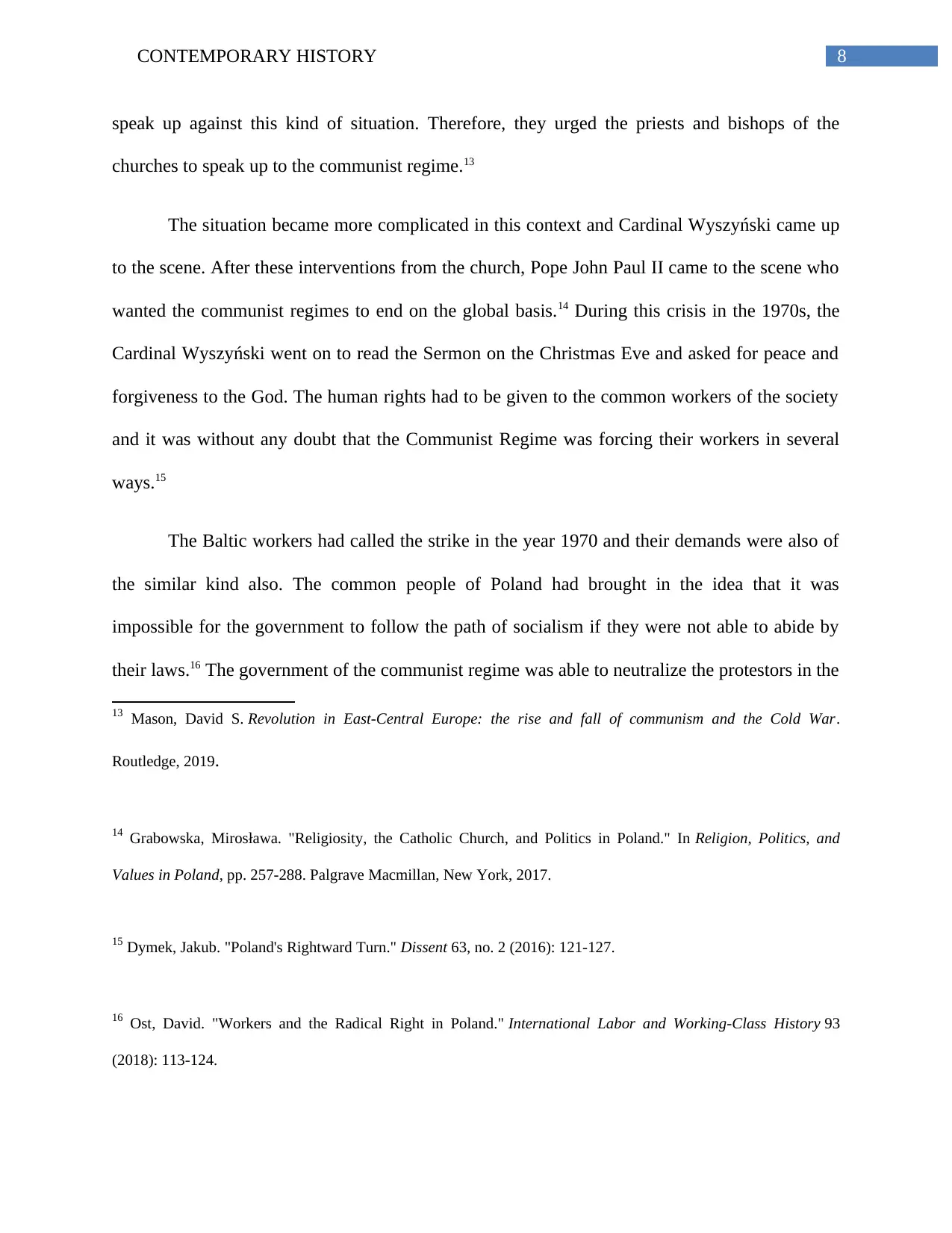
8CONTEMPORARY HISTORY
speak up against this kind of situation. Therefore, they urged the priests and bishops of the
churches to speak up to the communist regime.13
The situation became more complicated in this context and Cardinal Wyszyński came up
to the scene. After these interventions from the church, Pope John Paul II came to the scene who
wanted the communist regimes to end on the global basis.14 During this crisis in the 1970s, the
Cardinal Wyszyński went on to read the Sermon on the Christmas Eve and asked for peace and
forgiveness to the God. The human rights had to be given to the common workers of the society
and it was without any doubt that the Communist Regime was forcing their workers in several
ways.15
The Baltic workers had called the strike in the year 1970 and their demands were also of
the similar kind also. The common people of Poland had brought in the idea that it was
impossible for the government to follow the path of socialism if they were not able to abide by
their laws.16 The government of the communist regime was able to neutralize the protestors in the
13 Mason, David S. Revolution in East-Central Europe: the rise and fall of communism and the Cold War.
Routledge, 2019.
14 Grabowska, Mirosława. "Religiosity, the Catholic Church, and Politics in Poland." In Religion, Politics, and
Values in Poland, pp. 257-288. Palgrave Macmillan, New York, 2017.
15 Dymek, Jakub. "Poland's Rightward Turn." Dissent 63, no. 2 (2016): 121-127.
16 Ost, David. "Workers and the Radical Right in Poland." International Labor and Working-Class History 93
(2018): 113-124.
speak up against this kind of situation. Therefore, they urged the priests and bishops of the
churches to speak up to the communist regime.13
The situation became more complicated in this context and Cardinal Wyszyński came up
to the scene. After these interventions from the church, Pope John Paul II came to the scene who
wanted the communist regimes to end on the global basis.14 During this crisis in the 1970s, the
Cardinal Wyszyński went on to read the Sermon on the Christmas Eve and asked for peace and
forgiveness to the God. The human rights had to be given to the common workers of the society
and it was without any doubt that the Communist Regime was forcing their workers in several
ways.15
The Baltic workers had called the strike in the year 1970 and their demands were also of
the similar kind also. The common people of Poland had brought in the idea that it was
impossible for the government to follow the path of socialism if they were not able to abide by
their laws.16 The government of the communist regime was able to neutralize the protestors in the
13 Mason, David S. Revolution in East-Central Europe: the rise and fall of communism and the Cold War.
Routledge, 2019.
14 Grabowska, Mirosława. "Religiosity, the Catholic Church, and Politics in Poland." In Religion, Politics, and
Values in Poland, pp. 257-288. Palgrave Macmillan, New York, 2017.
15 Dymek, Jakub. "Poland's Rightward Turn." Dissent 63, no. 2 (2016): 121-127.
16 Ost, David. "Workers and the Radical Right in Poland." International Labor and Working-Class History 93
(2018): 113-124.
⊘ This is a preview!⊘
Do you want full access?
Subscribe today to unlock all pages.

Trusted by 1+ million students worldwide
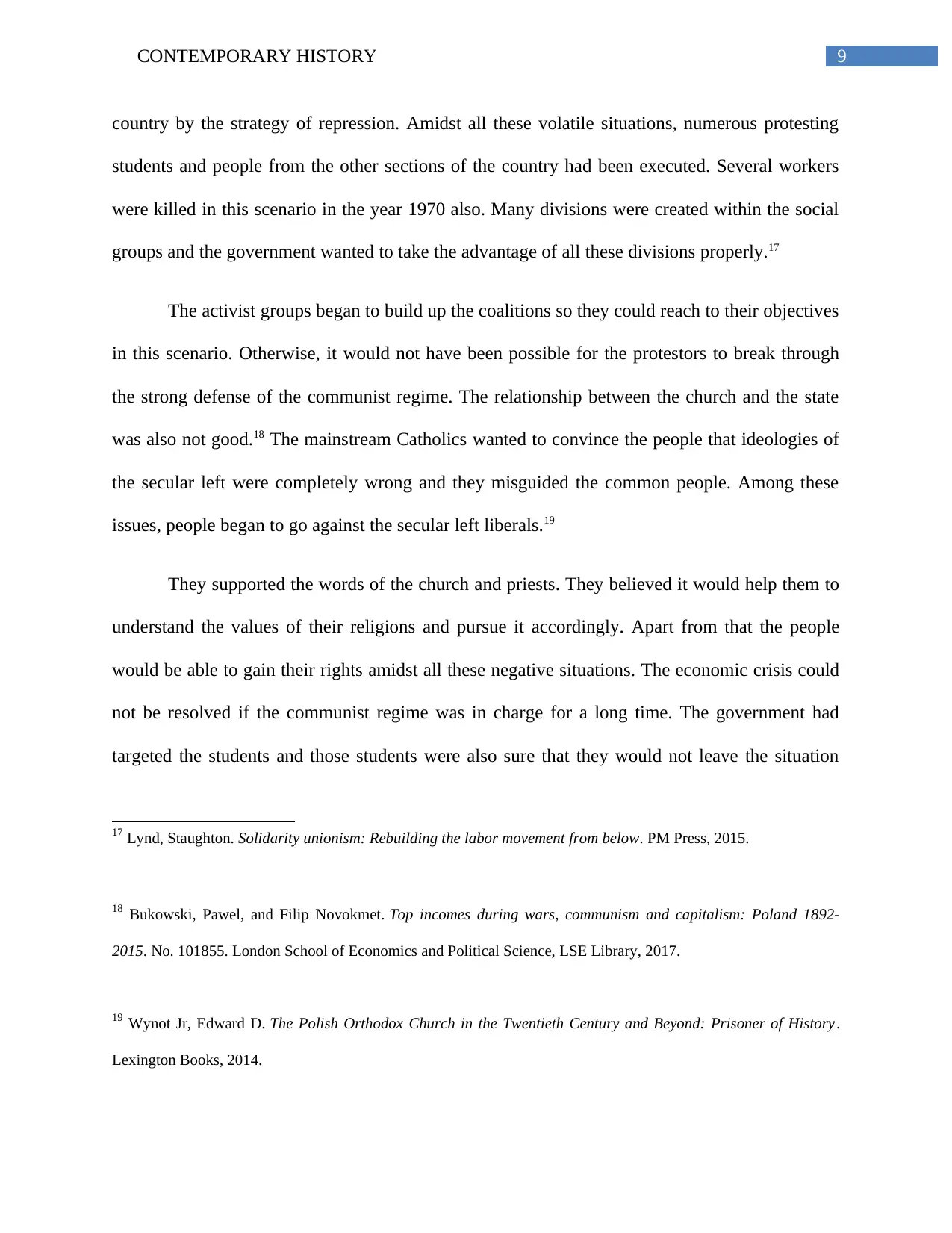
9CONTEMPORARY HISTORY
country by the strategy of repression. Amidst all these volatile situations, numerous protesting
students and people from the other sections of the country had been executed. Several workers
were killed in this scenario in the year 1970 also. Many divisions were created within the social
groups and the government wanted to take the advantage of all these divisions properly.17
The activist groups began to build up the coalitions so they could reach to their objectives
in this scenario. Otherwise, it would not have been possible for the protestors to break through
the strong defense of the communist regime. The relationship between the church and the state
was also not good.18 The mainstream Catholics wanted to convince the people that ideologies of
the secular left were completely wrong and they misguided the common people. Among these
issues, people began to go against the secular left liberals.19
They supported the words of the church and priests. They believed it would help them to
understand the values of their religions and pursue it accordingly. Apart from that the people
would be able to gain their rights amidst all these negative situations. The economic crisis could
not be resolved if the communist regime was in charge for a long time. The government had
targeted the students and those students were also sure that they would not leave the situation
17 Lynd, Staughton. Solidarity unionism: Rebuilding the labor movement from below. PM Press, 2015.
18 Bukowski, Pawel, and Filip Novokmet. Top incomes during wars, communism and capitalism: Poland 1892-
2015. No. 101855. London School of Economics and Political Science, LSE Library, 2017.
19 Wynot Jr, Edward D. The Polish Orthodox Church in the Twentieth Century and Beyond: Prisoner of History.
Lexington Books, 2014.
country by the strategy of repression. Amidst all these volatile situations, numerous protesting
students and people from the other sections of the country had been executed. Several workers
were killed in this scenario in the year 1970 also. Many divisions were created within the social
groups and the government wanted to take the advantage of all these divisions properly.17
The activist groups began to build up the coalitions so they could reach to their objectives
in this scenario. Otherwise, it would not have been possible for the protestors to break through
the strong defense of the communist regime. The relationship between the church and the state
was also not good.18 The mainstream Catholics wanted to convince the people that ideologies of
the secular left were completely wrong and they misguided the common people. Among these
issues, people began to go against the secular left liberals.19
They supported the words of the church and priests. They believed it would help them to
understand the values of their religions and pursue it accordingly. Apart from that the people
would be able to gain their rights amidst all these negative situations. The economic crisis could
not be resolved if the communist regime was in charge for a long time. The government had
targeted the students and those students were also sure that they would not leave the situation
17 Lynd, Staughton. Solidarity unionism: Rebuilding the labor movement from below. PM Press, 2015.
18 Bukowski, Pawel, and Filip Novokmet. Top incomes during wars, communism and capitalism: Poland 1892-
2015. No. 101855. London School of Economics and Political Science, LSE Library, 2017.
19 Wynot Jr, Edward D. The Polish Orthodox Church in the Twentieth Century and Beyond: Prisoner of History.
Lexington Books, 2014.
Paraphrase This Document
Need a fresh take? Get an instant paraphrase of this document with our AI Paraphraser
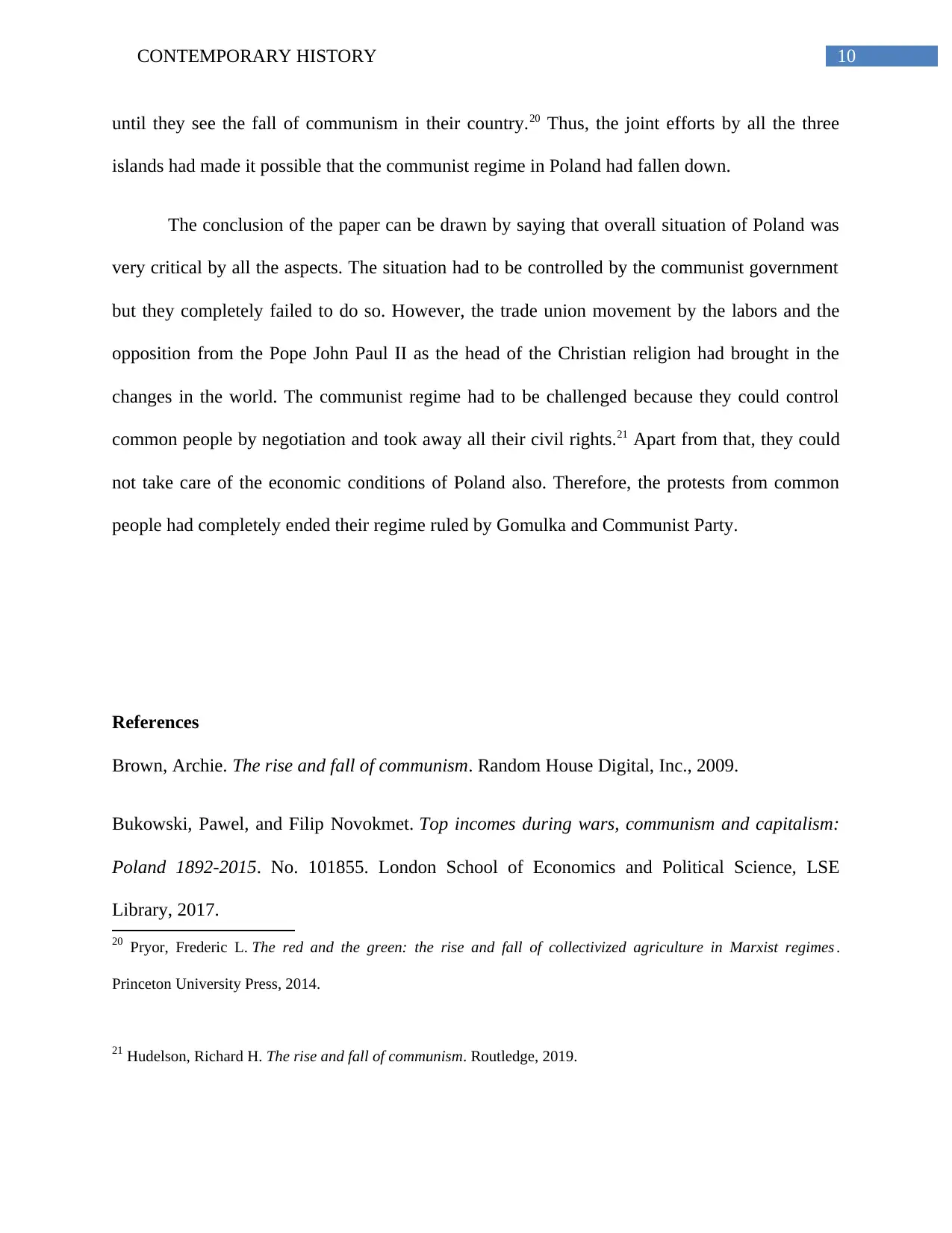
10CONTEMPORARY HISTORY
until they see the fall of communism in their country.20 Thus, the joint efforts by all the three
islands had made it possible that the communist regime in Poland had fallen down.
The conclusion of the paper can be drawn by saying that overall situation of Poland was
very critical by all the aspects. The situation had to be controlled by the communist government
but they completely failed to do so. However, the trade union movement by the labors and the
opposition from the Pope John Paul II as the head of the Christian religion had brought in the
changes in the world. The communist regime had to be challenged because they could control
common people by negotiation and took away all their civil rights.21 Apart from that, they could
not take care of the economic conditions of Poland also. Therefore, the protests from common
people had completely ended their regime ruled by Gomulka and Communist Party.
References
Brown, Archie. The rise and fall of communism. Random House Digital, Inc., 2009.
Bukowski, Pawel, and Filip Novokmet. Top incomes during wars, communism and capitalism:
Poland 1892-2015. No. 101855. London School of Economics and Political Science, LSE
Library, 2017.
20 Pryor, Frederic L. The red and the green: the rise and fall of collectivized agriculture in Marxist regimes .
Princeton University Press, 2014.
21 Hudelson, Richard H. The rise and fall of communism. Routledge, 2019.
until they see the fall of communism in their country.20 Thus, the joint efforts by all the three
islands had made it possible that the communist regime in Poland had fallen down.
The conclusion of the paper can be drawn by saying that overall situation of Poland was
very critical by all the aspects. The situation had to be controlled by the communist government
but they completely failed to do so. However, the trade union movement by the labors and the
opposition from the Pope John Paul II as the head of the Christian religion had brought in the
changes in the world. The communist regime had to be challenged because they could control
common people by negotiation and took away all their civil rights.21 Apart from that, they could
not take care of the economic conditions of Poland also. Therefore, the protests from common
people had completely ended their regime ruled by Gomulka and Communist Party.
References
Brown, Archie. The rise and fall of communism. Random House Digital, Inc., 2009.
Bukowski, Pawel, and Filip Novokmet. Top incomes during wars, communism and capitalism:
Poland 1892-2015. No. 101855. London School of Economics and Political Science, LSE
Library, 2017.
20 Pryor, Frederic L. The red and the green: the rise and fall of collectivized agriculture in Marxist regimes .
Princeton University Press, 2014.
21 Hudelson, Richard H. The rise and fall of communism. Routledge, 2019.
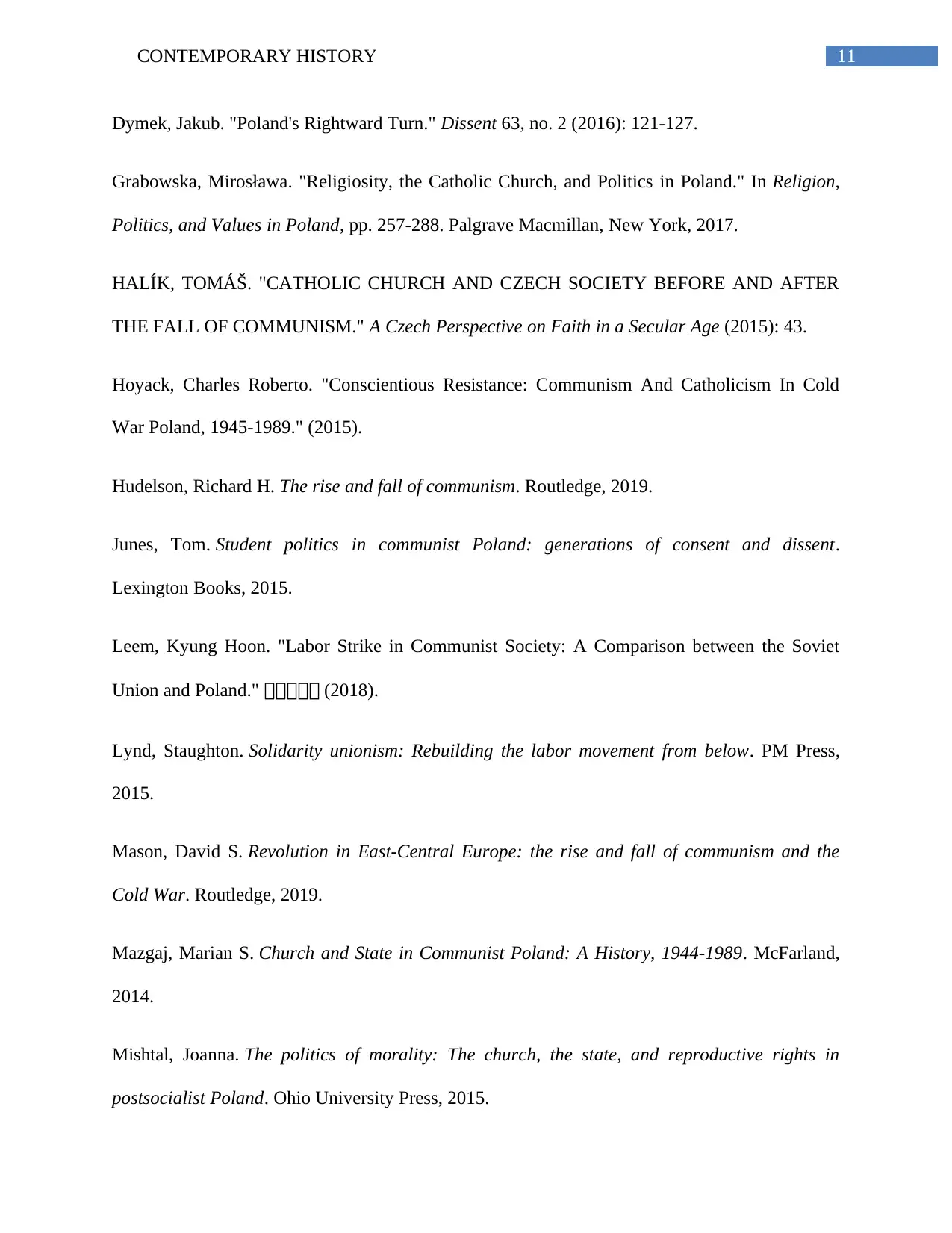
11CONTEMPORARY HISTORY
Dymek, Jakub. "Poland's Rightward Turn." Dissent 63, no. 2 (2016): 121-127.
Grabowska, Mirosława. "Religiosity, the Catholic Church, and Politics in Poland." In Religion,
Politics, and Values in Poland, pp. 257-288. Palgrave Macmillan, New York, 2017.
HALÍK, TOMÁŠ. "CATHOLIC CHURCH AND CZECH SOCIETY BEFORE AND AFTER
THE FALL OF COMMUNISM." A Czech Perspective on Faith in a Secular Age (2015): 43.
Hoyack, Charles Roberto. "Conscientious Resistance: Communism And Catholicism In Cold
War Poland, 1945-1989." (2015).
Hudelson, Richard H. The rise and fall of communism. Routledge, 2019.
Junes, Tom. Student politics in communist Poland: generations of consent and dissent.
Lexington Books, 2015.
Leem, Kyung Hoon. "Labor Strike in Communist Society: A Comparison between the Soviet
Union and Poland." 러러러러러 (2018).
Lynd, Staughton. Solidarity unionism: Rebuilding the labor movement from below. PM Press,
2015.
Mason, David S. Revolution in East-Central Europe: the rise and fall of communism and the
Cold War. Routledge, 2019.
Mazgaj, Marian S. Church and State in Communist Poland: A History, 1944-1989. McFarland,
2014.
Mishtal, Joanna. The politics of morality: The church, the state, and reproductive rights in
postsocialist Poland. Ohio University Press, 2015.
Dymek, Jakub. "Poland's Rightward Turn." Dissent 63, no. 2 (2016): 121-127.
Grabowska, Mirosława. "Religiosity, the Catholic Church, and Politics in Poland." In Religion,
Politics, and Values in Poland, pp. 257-288. Palgrave Macmillan, New York, 2017.
HALÍK, TOMÁŠ. "CATHOLIC CHURCH AND CZECH SOCIETY BEFORE AND AFTER
THE FALL OF COMMUNISM." A Czech Perspective on Faith in a Secular Age (2015): 43.
Hoyack, Charles Roberto. "Conscientious Resistance: Communism And Catholicism In Cold
War Poland, 1945-1989." (2015).
Hudelson, Richard H. The rise and fall of communism. Routledge, 2019.
Junes, Tom. Student politics in communist Poland: generations of consent and dissent.
Lexington Books, 2015.
Leem, Kyung Hoon. "Labor Strike in Communist Society: A Comparison between the Soviet
Union and Poland." 러러러러러 (2018).
Lynd, Staughton. Solidarity unionism: Rebuilding the labor movement from below. PM Press,
2015.
Mason, David S. Revolution in East-Central Europe: the rise and fall of communism and the
Cold War. Routledge, 2019.
Mazgaj, Marian S. Church and State in Communist Poland: A History, 1944-1989. McFarland,
2014.
Mishtal, Joanna. The politics of morality: The church, the state, and reproductive rights in
postsocialist Poland. Ohio University Press, 2015.
⊘ This is a preview!⊘
Do you want full access?
Subscribe today to unlock all pages.

Trusted by 1+ million students worldwide
1 out of 14
Your All-in-One AI-Powered Toolkit for Academic Success.
+13062052269
info@desklib.com
Available 24*7 on WhatsApp / Email
![[object Object]](/_next/static/media/star-bottom.7253800d.svg)
Unlock your academic potential
Copyright © 2020–2025 A2Z Services. All Rights Reserved. Developed and managed by ZUCOL.
